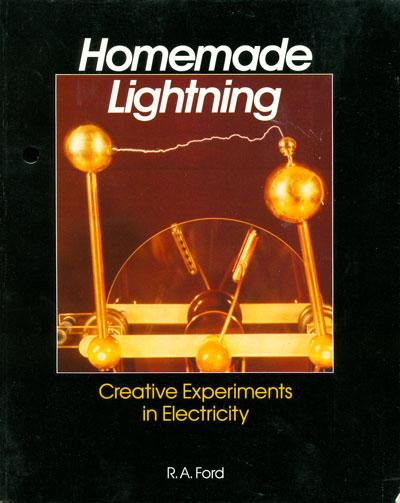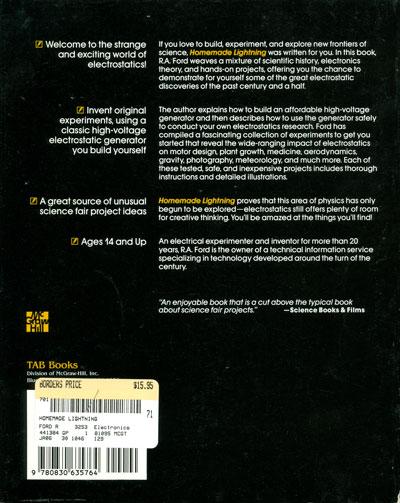
Nikola Tesla Books
Homemade Lightning: Creative Experiments in Electricity
Years ago, during my last year in high school, I decided to save up and buy a high-voltage Van de Graaff generator in kit form. I assembled and experimented with this machine, which had a spark potential of 500,000 volts; in the dry Connecticut winters it produced a 17-inch spark every second between its two large terminals. Many weekends were spent experimenting with the strange electrical forces and building capacitors for hotter sparks.
The fascination with high-voltage work in the lab and outdoors in nature's magnificent displays was kindled in me back then and has grown over the years. Even at that early stage, I knew this was an area of research that was not well understood or explained and I wondered whether such generators might ever have real, practical uses. Of course, today there are many industrial applications for electrostatics, such as removing dust from smoke stacks, paint spraying, and photocopying. But could an entirely new technology be developed for exploring the forces of nature and be as practical as was the application of steam power?
Modern electrostatics began about year 1660, when Otto von Guericke built spinning sulphur spheres, which were charged by the friction of the hand. Considerable experimenting was done from the latter half of the 1700s to about 1900. By this time, increasing interest was developing in the applications of that other aspect of electrical science - electromagnetism. Michael Faraday, Nikola Tesla, and Thomas Edison were largely responsible for this development. In time, physics books would treat the study of electrostatics primarily as an entertaining novelty with no practical use.
In spite of centuries of work, we still need much more understanding of the nature of electric “charge”, of how electric forces act across space, and of how electric potential energy is stored. At the very least, this would help to understand how thunderstorms develop.
This books is divided into two parts; the first part describes high voltage generator design and construction with brief mention of theory of operation. The second part details the basic instruments used with the generator and some of the areas wide open for pioneers. As the title implies, this book is not written for the couch potato who waits passively to be entertained, but rather for those who love to build, experiment and investigate along original lines of research. I am especially interested in encouraging high school students and their teachers who want to do something really unusual for their science fair projects. A basic grasp of electrostatic principles is helpful on the theoretical side.
The Wimshurst disc-type generator and its modifications is selected as a very versatile, compact, and reliable machine. An intermediate level of skill in wood, metal and plastics working, as given in high school industrial classes, is needed for generator construction. In this way, hands-on physics experiments are combined with manual skills that emphasize the importance of the industrial arts, directed towards the high goal of scientific research. Sources for construction materials are provided.
For those who work in the high-technology field but find their job uninspiring - who need more feel for practice than for pure theory or find themselves morally opposed to the direction their technical work is taking - take heart. There is plenty of room in the science of electrostatics for creative thinking!
In order to get as many readers involved as possible, I have designed my generators and accessories with the idea of reasonable cost and readily available materials foremost in thought. I provide sources for parts not locally available.
When you are finished with this book, you will be able to walk into hardware, fabric, auto parts, and arts and crafts stores and see completely novel uses for ordinary products. Of course, the store clerks might be baffled by your excitement!
A well-made high-speed generator can deliver much more voltage at reasonable charging current as industrial power supplies costing thousands of dollars, yet without transformers, rectifiers, and filter systems. Although high-voltage electricity does have great entertainment value, my main objective is to revive it as a serious tool for physics research.
Whatever your interest, please enjoy and happy motivating!


